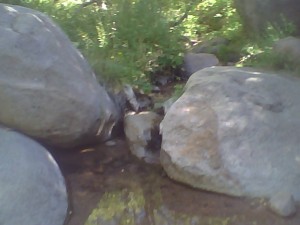In search of the juniper titmouse and random desert wrens, I headed up the Domingo Baca trail in the foothills above Albuquerque this morning. As is the case with most of the little canyons on the west face of the Sandias, there’s a spring near the bottom of Domingo Baca Canyon. The tilt of the rock causes the water to pool behind a layer of granite and rise to the surface at basically the same strata in each canyon, near the base of the mountains. At least that’s what I think explains it. The little green patches are lovely and always popular, with hikers and with birds. (Apologies for the picture, as I only had a cell phone with me.)
Baca was an old sheepherder, or so the story goes, and you can still see what they say is the remains of his rock hut on one side of the canyon just downstream from the spring. There is no perennial water flowing out of the Sandias into the desert below, but up in these canyons the springs, feed by snowmelt, run year ’round. It’s where I’d put my cabin too if I was herding sheep.
There were some broad-tailed hummingbirds, presumably on their annual commute, stopping for a drink. Well, not so much “stopping” as flying frantically and acting confused by the bright reddish pink shirt of a woman who arrived at the spring the same time I did.
I saw a flock of juniper titmouses (titmice?) and the wonderful fall nut-burying behavior of the scrub jays. You can here the “tap tap tap” as they poke it into the dirt. But no wrens today, at least that I could find.

